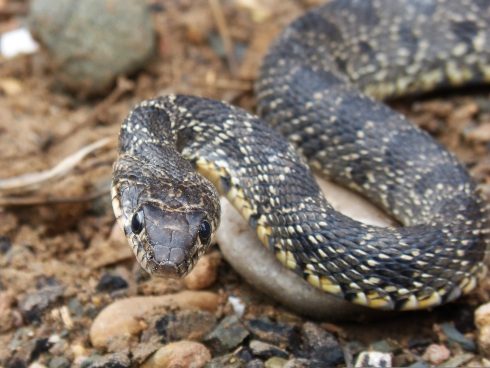Bob Maddox admits to his addiction as the south of Spain bursts into a riot of red and green
DURING the summer of 1874, CR Wright – a chemist at St. Mary’s Hospital, London – was on the trail of a new drug which would revolutionise the treatment of pain.Morphine, named after the Greek God of dreams, Morpheus, was proving dangerously addictive and a substitute was needed.
Wright discovered a new form of morphine called diacetylmorphine; more potent than the original. Strangely, Wright ceased his experiments without marketing the new drug.
Twenty-three years later, Felix Hoffmann, a chemist at Bayer pharmaceuticals in Germany, independently discovered the same compound. Bayer were onto a winner; the wonder drug – a non-addictive substitute for morphine.
Since diacetylmorphine lacked the sparkle necessary for successful marketing, Bayer invented a snappier name to highlight their new drug’s heroic role in the battle against pain. From the German heroisch, the name Heroin was born.
Until its withdrawal by Bayer 12 years later, heroin was routinely prescribed as a non-addictive morphine substitute and as a cough medicine for children. Oh dear.
Confession
Papaver Somniferum (meaning “sleep bringer”) is the Latin name for the plant which yields the milky sap from which opium, morphine and heroin are derived. That a single plant could be the source of so much human misery and yet so much medical benefit, is just one facet of the fascinating story of Papaver; the heroic family of weeds which we all know as poppies.
Let me confess right here in these august pages, I am addicted to many of the products of Papaver. For several weeks a year I find myself in another hallucinogenic world, in which the complimentary colours red and green dance across the landscape in a visual blizzard as a cousin of the opium poppy arrives to blitz the senses. And it is happening right now across southern Spain as the corn poppy (Papaver rhoeas) makes its appearance.
Fields, olive groves, even those road works – anywhere the soil has been disturbed, can undergo a fabulous, vibrant transformation during spring and early summer, as seeds which have lain dormant for years sense the disturbance and burst into life. This is the great survival strategy of the poppy: to lie in wait until the ground is disturbed, then race into life and occupy the land before anything else has a chance to compete.
Man, flower and war
As the Neolithic tribes migrated from the eastern Mediterranean northwards across Europe at the end of the Pleistocene Ice Age, so Papaver rhoeas followed, forging a close link with agriculture and becoming the major weed of cultivation.
Following the plough northwards, the corn poppy added its own haunting beauty to the agricultural landscape, becoming a favourite subject of Monet, Van Gogh and other impressionists. Interestingly, poppy seed oil is still used in the making of oil paints.But it was in the fire and flying metal of mechanized warfare that its most poignant image was to be forged. As the earth was wounded by shells and ploughed by the trenches of World War I, so papaver, with its trick of exploiting disturbed ground, was to turn the battlefields of Western Europe scarlet. Where all else was barren desolation, the corn poppy stood bright and clear, its scarlet flower evocative of the spilt blood of millions of young men.
Outside a field dressing station near Ypres in May 1915, a young Canadian surgeon, John McCrae surveyed the graves of his dead comrades; their freshly turned soil marked by scarlet poppies. In his anguish, McCrae scribbled a short poem in his notebook. In Flanders’ Fields was to become the iconic voice of Remembrance and the scarlet corn poppy its image.
Herbal remedy
Poppies also make for good eating. From salad dressings through to bagels and hamburger buns, those attractive nutty-tasting poppy seeds excite the taste buds. Have a care though; they are slightly narcotic and volunteers have tested positive for opiates after eating only two bagels.
This appears to have escaped the attention of the population of Lithuania, where a traditional Christmas Eve dish consists of yeast biscuits soaked in ground poppy seeds and water – or perhaps that is the only way to tolerate Christmas in Lithuania?
Incidentally, there are around 1,980,000 poppy seeds to the kilogram, just in case you had ever wondered. Also, poppy seeds are extremely popular with canaries, which might explain why they sing so much.
In addition to modern medicine, poppies have also retained a firm foot in the herbal remedy camp. A host of respiratory complaints are said to respond to poppy treatment.
Cough? Try adding poppy petals to a mug of boiling water. I found it made a splendidly attractive and oddly refreshing pink drink, which had absolutely no effect whatever on my cough. Next time, I am back on penicillin.
Anxiety? Try the flower that was used to put Dorothy to sleep in The Wizard of Oz.
Vertigo? Try poppy seeds and coriander mixed with rose water and a touch of sugar to kill the vile taste.
Art, poetry, history, mythology, medicine, cooking and war – there are few aspects of human endeavour that remain untouched by the poppy. This staggeringly beautiful plant is inextricably bound up with our lives.
And nowhere is this more wonderful than where our ploughs and blades have passed over the olive groves, fields, roadsides and ditches of this beautiful land during the months of May and June.
Papaver, the Heroic Weed is out there waiting for you. But beware – it really is addictive.






Will longstaff painted Menin gate at midnight (ghosts of menin gate) 1927 which is on exhibit at the Australian War memorial. During a midnight walk along the Menin road in Ypres, the artist had a vision of steel-helmeted spirits rising from teh moonlit cornfields around him. In the fields were also the bright flowers of the poppies indicative of the spilt blood. It was an eerie but moving oil painting. Now I understand why the red poppy is used to commemorate the loss of soldiers at war memorials. Thank you it was an insightful article.